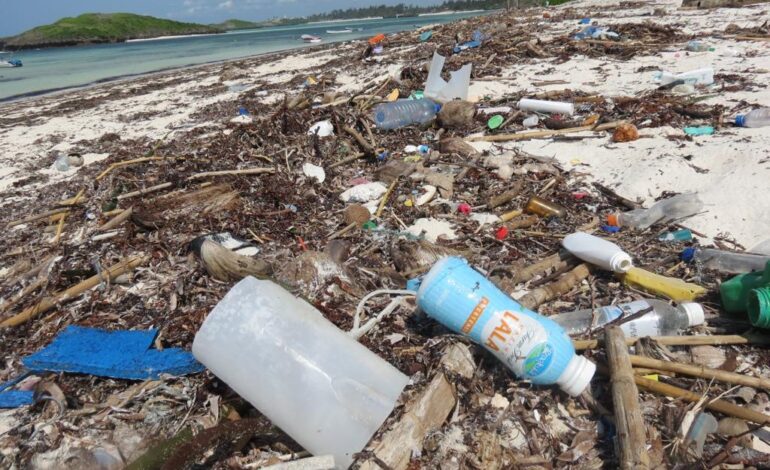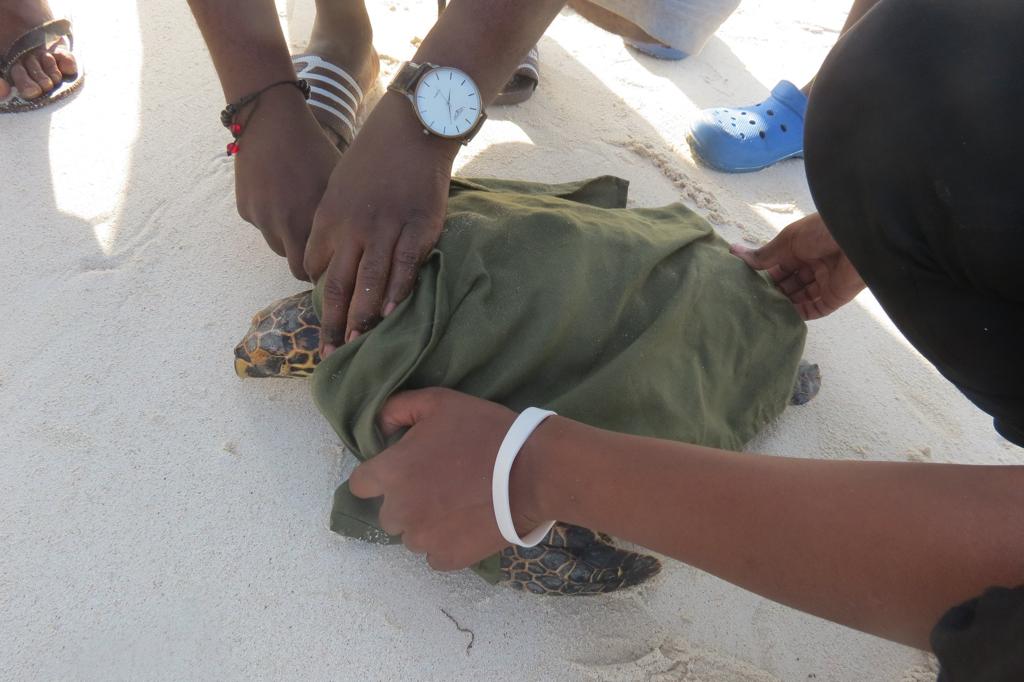
Faith Nyasuguta
During the COVID-19 pandemic, consumption of single-use plastics grew by 250-300%, according to the International Solid Waste Association.
This points to an urgent need for a greater sense of responsibility, in the quest for building back better and greener. For Kenya alone, about 37,000 tonnes of plastics are emptied into the marine ecosystems each year. For some African nations, the figure could be higher.
Africa Equity Media spoke to Kevin Lunzalu, a marine ecologist who gives insight on the effect of plastic pollution on the marine ecosystem across Africa, with reference to Kenya:

The impact of marine pollution extends beyond environmental damage, as it also directly affects a country’s economy. The value derived from oceans, also known as marine ecosystem value, decreases by 1-5% each year due to plastic pollution.
Healthcare, aquaculture, and tourism are some of the major sectors that are adversely affected economically by the growing threat of marine pollution.
Scientists estimate that the world loses up to 2.5 trillion dollars annually due to coastal pollution. Countries like Kenya, which has a large coastal tourism industry, are poised to take major economic hits from the crisis.
For each tonne of plastic that enters the ocean, up to $33000 is lost in monetary value.
The youth have been at the forefront of addressing the evolutionary monster of plastic pollution that has been labeled the third environmental crisis the world is facing today, together with climate change and biodiversity loss.
One such initiative that was started at the height of the daunting COVID-19 in 2020, is Plastic off turtles, a project that seeks to highlight the plight of Kenya’s endangered sea turtles in the wake of increased marine pollution, especially plastics.
It sought to co-create community-focused solutions that address the impacts of plastic pollution on key marine species, using sea turtles as the indicators of the health of our marine environmental health.
While hatching sites for the endangered sea turtles were generally safer during the pandemic due to less human traffic on critical nesting beaches, the consumption of plastic skyrocketed, with a direct negative impact on the health of sea turtles, further threatening their populations.
While it may take generations to rectify the damage to marine ecosystems, it is important to note that we can kickstart that process now through devolved meaningful policy changes and collection action.
Kenya is home to five of the world’s seven species of sea turtles-green, leatherback, loggerhead, olive ridley, and hawksbill. About 3 decades ago, Kenya’s coastline served as a nesting haven for sea turtles.
The situation has since changed for the worse, with modern challenges like marine pollution posing the greatest danger to these charismatic reptiles. Incidents of dead sea turtles in plastic sacks have been recorded along the Kenyan coast.
Africa cannot afford to lose its remaining population of sea turtles. The shelled creatures play an integral role in the sustainability of both marine and beach ecosystems.
In the waters, sea turtles feed on a variety of sponges, jellyfish, and seagrasses, which in turn sustains the productivity and nutrient cycles of the ocean. Their feeding preferences also aid the development of coral reef ecosystems, a key coastal tourism pillar.
Keeping the seagrasses trimmed also facilitates a smooth flow of currents, which benefits other marine organisms. Their overly attractive nature earns them the attention of tourists, especially those who enjoy diving in warm coastal waters.

Besides, sea turtles directly contribute to the ecological wellbeing of coastal ecosystems that provide a fundamental base for coastal tourism.
Despite being marine foundation species, for their crucial ocean ecosystem engineering role, sea turtles are on a sharp decline in Africa with some of them considered critically endangered. If unchecked, the continued reduction of sea turtles means the remaining populations will no longer be enough to play a significant role in maintaining the quality of our wonderful beaches.
The nesting of sea turtles on the beach strengthens its vegetation cover, species distribution, and stability through the deposition of important nutrients such as phosphorus, nitrogen, and potassium by unhatched eggs. When the roots of these plants flourish and their strength increase, they become efficient in controlling beach erosion by holding the sand.
The sustained growth of coastal vegetation and stabilization of beaches positively contributes to the overall health of the beach ecosystem, benefitting other plants, animals, and humans that depend on it.
Enhanced coastal resilience is important for the livelihoods of many Kenyans, especially those in the fishing and tourism industries. Kenya’s Diani beach, for example, an important sea turtle nesting hub, is recognized as one of the world’s leading tourist destinations due to its clean white sands. Tourism contributes about 10% of Kenya’s revenue and employs over 2 million people.
In 1998, the United Nations Environmental Programme (UNEP) pointed out erosion and coastal pollution as the main threats facing sea turtle nesting areas on Kenya’s 200KM coastline. The challenges have since been catalyzed by coastal development, poaching, and climate change, resulting in unprecedented marine biodiversity loss.
The Plastic Off Turtles has aided in the safeguarding of critical nesting sites of sea turtles along Kenya’s South Coast, from Diani to Vanga, where three species of sea turtles-green, hawksbill, and olive ridley- have been documented to nest. Between January and May each year, female sea turtles come off the water to lay their eggs in the sand.
Studies have shown that eggs represent one of the most critical and vulnerable stages for sea turtles since their survival is dependent on several external environmental factors. Increased accumulation of microplastics in nesting sites can significantly reduce hatching success by altering the natural temperatures of the nests.
Plastic in Africa’s oceans mainly originates from mismanaged waste, improper dumping from commercial and household sources, recreational activities, sewer overflows, and treatment plant overflows. Land-based activities account for 80% of Kenya’s marine waste.

The waste ends up in streams, sewage systems, beaches, rivers, and drainage systems and eventually in the oceans. Species that depend on beaches and marine waters for nesting and feeding, such as sea turtles, are continuously negatively impacted by the pollution, which results in a significant reduction in their populations.
It is critical for the public and all stakeholders to understand that the ocean goes beyond the beach area and that activities on land directly impact our ocean ecosystems.
Plastics also originate from sea-based sources, including discarded and abandoned fishing gear, fishing vessels, recreational boats, port facilities, offshore mining vessels, and direct disposal at the sea.
In 2021, the Kenyan Youth Biodiversity Network documented some threats facing sea turtles in Kenya, mainly marine pollution and poaching.
One of the biggest challenges in tackling marine plastics is their transboundary nature. Currently, countries in East Africa do not have the capacity and resources to adequately determine the quantities and respective sources of plastic that end up in their oceans.
This is largely the reason why even though Kenya has active nationwide bans on plastic bags and single-use plastics in protected areas, threats related to plastics are still dire. We all need to realize that we could have shared differentiated responsibilities to reduce our contribution to the landfills. Governments ought to adequately invest in recycling infrastructure and mend the currently broken waste management value chain.
Consumers, who account for the majority of plastic waste in Kenya, are not obliged by law to do so. There are no incentives for consumers to shift to ecologically sustainable alternatives to plastic, which makes it a pipe dream to attain plastic-free ocean environments in Kenya. Increased investment in plastic waste will generate market value, a factor that could drive recycling upwards, through increased employment of waste pickers.
Governments must step up their oversight role of existing bans and laws through increased enforcement.
Kevin Lunzalu is a Kenyan wildlife ecologist, currently a graduate student at the University of California, Santa Cruz, studying Coastal Science and Policy. He is also the co-founder of the Kenyan Youth Biodiversity Network, a youth-led organization that rallies and empowers young people to take meaningful action toward the protection of the environment and combating climate change.




